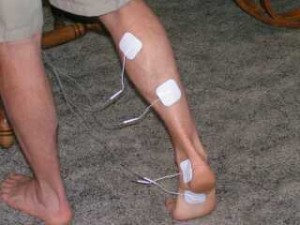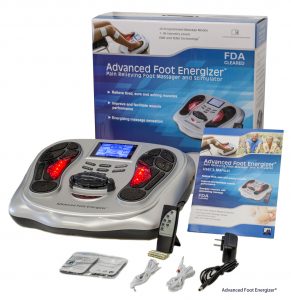Foot Pain Associated with Plantar Fasciitis Pain and Relief, Heel Spur Syndrome, and Other Foot Pain
Plantar Faciitis pain and relief from foot pain is an important topic for any pain relief reference.
Plantar fasciitis: “Inflammation of the plantar fascia (fasciitis), the “bowstring-like” tissue in the sole of the foot stretching from the heel to the front of the foot.” – The Medterms Dictionary.
Plantar Fasciitis and Heel Spur Syndrome: What are they?
Pain in any form reduces the joy of everyday living. Your focus is not on the things you want (and need) to do but is instead on where you’re hurting. One common complaint is pain from Plantar Fasciitis and Heel Spur Syndrome.
It’s important to understand what Plantar Fasciitis and Heel Spur Syndrome are and how they are connected.
From WebMD, we see how the two medical concerns interact: a “heel spur is a calcium deposit causing a bony protrusion on the underside of the heel bone. On an X-ray, a heel spur can extend forward by as much as a half-inch. Without visible X-ray evidence, the condition is sometimes known as “heel spur syndrome.”Although heel spurs are often painless, they can cause heel pain. They are frequently associated with plantar fasciitis, a painful inflammation of the fibrous band of connective tissue (plantar fascia) that runs along the bottom of the foot and connects the heel bone to the ball of the foot. Heel spurs are often caused by strains on foot muscles and ligaments, stretching of the plantar fascia, and repeated tearing of the membrane that covers the heel bone.”
Just to be clear as to what the plantar fascia is, it is a thick, broad, inelastic band of fibrous tissue that runs along the bottom (plantar surface) of the foot. It is attached to the heel bone (calcaneus) and fans out to attach to the bottom of the metatarsal bones in the area of the ball of the foot. Because the normal foot has an arch, this tight band of tissue is at the base of the arch. In this position, the plantar fascia acts like a bowstring to maintain the arch of the foot.
We now know what the two pain-causing issues are and that they are connected. The heel spur itself is not what causes the pain. When the inelastic band of fibrous tissue that makes up the plantar fascia becomes stretched out, tiny tears can occur in its surface. This causes inflammation and pain. Heel spurs are now thought to be the result of the pain from Plantar Fasciitis.
Calcaneal Spur Syndrome The spur is a bony exostosis (well defined on x-ray) that originates at the inner weight-bearing tuberosity of the calcaneus and extends forward horizontally toward the plantar fascia. Spurs result probably from an excessive pulling or stretching of the calcaneal periosteum by the plantar fascia. Excessive stretching may result in pain along the inner border of the plantar fascia (plantar fasciitis). Disorders associated with an increase in plantar fascial tension may include flatfeet and contracted heel cords. The Merck Manual
What are the symptoms of Plantar Fasciitis?
The classic sign of Plantar Fasciitis is heel pain with the first few steps in the morning or after periods of prolonged sitting. The pain is usually in the front and bottom of the heel, but can be anywhere along the length of the plantar fascia. Pain often will diminish as the muscle warms up. Plantar fasciitis starts out as a sharp pain that turns into a duller, intermittent pain as the day progresses. The pain usually increases after standing or walking for long periods of time, and at the beginning of a sporting activity.
Similar sensations to Plantar Fasciitis pain may occur with bone trauma or other injury to the soles of your feet. You may also experience sharp heel pain if the cushion layer of tissue over your heel is too thin. Either way, the debilitating pain to the area can sharply reduce the quality of life.
Possible causes of Plantar Fasciitis and general foot pain:
- Repetitive stretching of a tight plantar fascial band leads to micro tears at the calcaneal origin
- Obesity or sudden weight gain
- Tight Achilles tendon
- Change in walking or running habits
- Use of shoes that are too small or have poor cushioning
- Running on toes, hills or very soft surfaces
- Change in running or walking surface
- Occupation that requires long periods of standing or walking (policeman’s heel)
- Excessive pronation, flat feet or high arch.
It’s important to note that Plantar Fasciitis can become a chronic condition if left unchecked. In very few cases, surgery may be required.
How can Plantar Fasciitis and Heel Spur Syndrome sufferers ease their pain?
Following are some non-medicinal/non-surgical suggestions for Plantar Faciitis pain and relief and solutions to foot pain:
- Stretching the calf muscle several times a day, especially in the morning and after prolonged sitting.
- Ice after activity.
- Rest and heat.
- Arch supports, or orthotic devices especially for flat feet and high arches.
- Lose weight if possible; this helps relieve the excess tension in the planter fascia.
Are there any other methods of finding relief for my suffering?
There are other methods that therapists use to provide pain relief for Plantar Fasciitis.
One such method is the use of electrical stimulation which is specifically designed to stimulate the soles of your feet (plantar surface). It helps alleviate your pain and condition your muscles. (Please see the study abstract below regarding using electrical stimulation for Plantar Fasciitis.)
Using TENS (Transcutaneous Electrical Nerve Stimulation) effectively blocks pain signals to the brain. Then using low-frequency EMS (Electrical Muscle Stimulation) helps to condition the muscles in your feet and legs and helps increase and improve the blood circulation in the localized area. This helps bring blood full of nutrition and oxygen to the tissues in your feet and legs while pulling toxins away. The EMS will have a more subdued but longer effective result for pain relief while helping the tissues heal.
- Rhythm Touch electrical muscle stimulator and the Advanced Foot Energizer have proven effective in relieving pain.

Typical Rhythm Touch 2-Way pad placement for Plantar Fasciitis - The Advanced Foot Energizer EMS and TENS Combination Stimulator is both a TENS and EMS designed specifically for your feet and legs and is the easiest prescription strength machine available over-the-counter delivering low frequency stimulation to the soles of your feet and to your legs. It is a very effective system for delivering electrical stimulation to your feet for pain relief and healing. Try it for your feet risk free with our money back guarantee. Learn more at advancedfootenergizer.com
Save 10% on Advanced Foot Energizer, Rhythm Touch Supplies. Join newsletter for code.
Use of low-frequency electrical stimulation for the treatment of plantar fasciitis.
Abstract
BACKGROUND:
Recent research has discussed the use of low-frequency electrical stimulation to increase blood flow by eliciting muscular contraction in soft tissues. This randomized clinical trial examined the efficacy of low-frequency electrical stimulation combined with stretching exercises and foot orthoses in individuals diagnosed as having plantar fasciitis for less than 6 months.
METHODS:
Twenty-six participants aged 18 to 65 years diagnosed as having plantar fasciitis were randomly assigned to two treatment groups: a control group receiving only stretching and orthoses and a treatment group receiving low-frequency electrical stimulation in addition to stretching and orthoses. To assess treatment response, a visual analog scale was used to determine first-step morning pain, and changes in daily activity levels were monitored by using a validated outcome measure. All of the participants were assessed before starting treatment, after 4 weeks of treatment, and 3 months after the conclusion of treatment.
RESULTS:
Participants in the control and experimental groups demonstrated pain reduction and improvements in functional activity levels after 4 weeks and 3 months.



Do you have experience using electrical stimulation for PF?
Hi DC,
I personally used the Advanced Foot Energizer to help me recover from Plantar Fasciitis.
What I found was that using the TENS modes helped with quick pain relief while using the EMS modes helped with long term recovery. I personally like mode 24 (Shiatsu), mode 7 (pulling massage) and mode 8 (pushing massage). Honestly I use mode 7 the most but like to change now and then so that I don’t experience muscle memory. I generally use mine at an intensity of about 65. Everyone is different about intensity. I have a friend who never goes above 20.
For me it took some time to recover but I was already speaking with a surgeon who recommended electrical stimulation as an option to try first. I also added some inexpensive insoles to my shoes to help with cushioning my feet: the “FREEDOM High Impact Accommodator” which you can find on Amazon.
Now I’m able to trail run again 3 or 4 times per week and use the Advanced Foot Energizer in the evening after running. It’s so great not experiencing the broken glass feeling when getting out of bed in the morning.
The studies done in testing the TENS units in my opinion and experience with a calf muscle tear, do not use the TENS unit enough for a sufficient effect. A one time per day treatment is akin to doing one set of reps while working with weights in other muscle groups. Improvement? Maybe. Good muscle growth and strengthening? Not likely.
In identical torn calf muscle incidents where the first was treated with standard PT and rehab, was 6 weeks. The next year the opposite calf tore.
Using Arnica Montana and a handheld TENS unit all day and all waking night yielded 3 weeks heal time.
The TENS unit cables were run up the leg over the waistband and into the pocket. No one could tell a treatment was going on.
Back on the karate floor in 3 weeks over 6 weeks. I’ll take that any day.